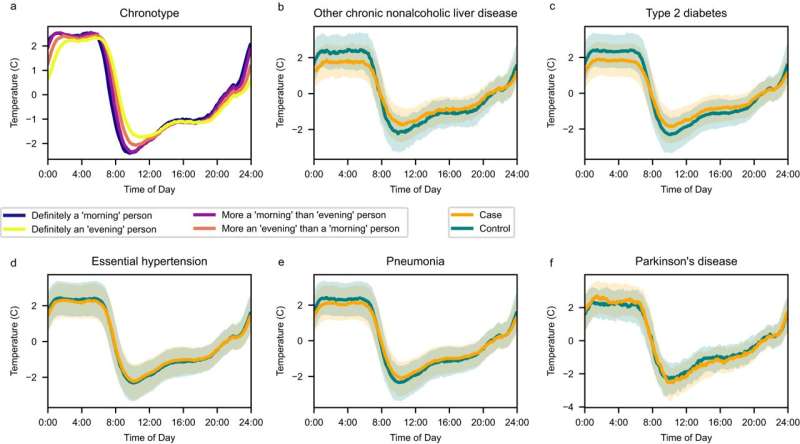This article has been reviewed according to Science X's editorial process and policies. Editors have highlighted the following attributes while ensuring the content's credibility:
fact-checked
peer-reviewed publication
trusted source
proofread
Study finds wrist temperature linked with future risk of disease

Continuous wrist temperature monitoring can uncover insights into the potential for future disease risk for ailments like type 2 diabetes, hypertension, liver disease, kidney failure, and more. These new findings from Perelman School of Medicine researchers, recently published in "Nature Communications," shows that accurate, continued digital monitoring of skin temperature can give deeper medical insights.
Previously, disrupted temperature rhythms had only been linked to a handful of conditions, such as metabolic syndrome and diabetes. Now, this research provides insights from a large population, and it indicates a wider spectrum of conditions are associated with poor temperature rhythms, measured in wrist temperature amplitude (the difference between the minimum and maximum temperature over the course of 24 hours).
"These findings indicate the potential to marry emerging technology with health monitoring in a powerful new way," said Carsten Skarke, MD, an adjunct associate professor of Medicine, Robert L. McNeil, Jr. fellow in Translational Medicine and Therapeutics, and the study's senior author. "For example, there are many who have smart watches around their wrists, which already include skin temperature sensors. In the future, this information may be leveraged with their care teams as a digital biomarker, to understand their risk to develop certain diseases and to navigate treatment or preventative care options."
In this study, one week of data from more than 92,000 UK Biobank participants were collected at home during typical daily activities, including sleep. The participants had their wrist temperature rhythms monitored which tracks the day to night changes of their wrist body temperature. This included both circadian as well as sleep-wake behavior, along with components impacted by environmental conditions, such as reduction of core temperature during periods of sleep.
The findings indicate that the daily peaks and valleys observed in one's wrist temperature curve might matter for health. The flatter this landscape becomes the higher the risk for chronic diseases.
The researchers found that up to 73 different disease conditions were significantly associated with decreased temperature rhythm, meaning that participants with a smaller day-night difference in their wrist temperature readings showed increased rates for a future onset of these diseases.
Among the largest associations, nonalcoholic fatty liver disease (NAFLD) emerged with a 91% increased risk for these participants, followed by type 2 diabetes with 69%, renal failure with 25%, hypertension with 23%, and pneumonia with 22%. The research team took these data and compiled them into an easily searchable website, the Temperature Biorhythm Atlas.
"While temperature rhythms are only one aspect of one's circadian health, these findings add to a growing body of work that shows the importance of maintaining healthy circadian habits, such as the consistent timing of sleep and physical activity," said Thomas Brooks, Ph.D., the lead author and a research associate in Translational Medicine and Therapeutics at Penn.
Future studies may expand upon this work with additional data from new smartwatch-based measurements and include younger or more diverse participants, alongside additional investigations that target temperature rhythms, to better understand the underlying biology.
More information: Thomas G. Brooks et al, Diurnal rhythms of wrist temperature are associated with future disease risk in the UK Biobank, Nature Communications (2023). DOI: 10.1038/s41467-023-40977-5



















